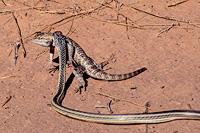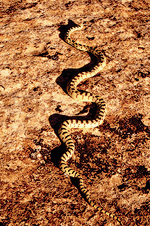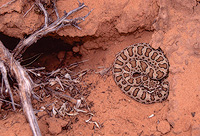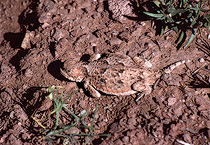 As summer begins in the Canyonlands region, one group of wildlife becomes very active: the reptiles. Many consider snakes and lizards to be the quintessential desert creature, the species they most expect to see on a warm summer day. Along with that expectation is a slight tinge of fear of rattlesnakes, but the park rangers will tell you, you’d be lucky to see one! Factual, but maybe not reassuring.
As summer begins in the Canyonlands region, one group of wildlife becomes very active: the reptiles. Many consider snakes and lizards to be the quintessential desert creature, the species they most expect to see on a warm summer day. Along with that expectation is a slight tinge of fear of rattlesnakes, but the park rangers will tell you, you’d be lucky to see one! Factual, but maybe not reassuring.
Reptiles regulate their body temperatures through environmental sources, that is why they are active in summer and dormant in winter. Considered “cold-blooded” (ectothermic if you’re into the terminology), reptiles stay warm sunning themselves or collecting heat off of roadways and ground surfaces. It doesn’t take much effort for these creatures to stay warm in this desert environment. Reptiles do have to adjust their activity level when the temperatures get above 100⁰F because they can’t sweat to cool themselves off.

One advantage ectotherms have over other wildlife is that they expend minimal energy staying warm and having to search for prey. In A Naturalist’s Guide to Canyon Country by David B. Williams, he writes, “One study found that ‘one day’s food for a small bird will last a lizard of the same body size more than a month.’”
 Of course, this doesn’t mean that lizards and snakes don’t eat much at all. A common sight is to see lizards scurrying after insects or even each other, or a snake with a protruding belly digesting its latest prey. One feature that lizards have is to store fat in their tails to survive the winter or periods inactivity. Losing their tail is extremely stressful to these creatures, so please avoid the temptation to try and catch one of these desert dwellers; their life could be literally in your hands.
Of course, this doesn’t mean that lizards and snakes don’t eat much at all. A common sight is to see lizards scurrying after insects or even each other, or a snake with a protruding belly digesting its latest prey. One feature that lizards have is to store fat in their tails to survive the winter or periods inactivity. Losing their tail is extremely stressful to these creatures, so please avoid the temptation to try and catch one of these desert dwellers; their life could be literally in your hands.
Snakes
Nine different species of snake inhabit a wide range of habitats in the Canyonlands area. These include garter snakes, whipsnakes, gopher snakes, and rattlesnakes, and though any snake will bite, rattlesnakes are the only venomous snake. Dogs probably get bitten more than humans (still pretty low odds) so be aware when hiking with your pooch in the desert.
 Gopher or bull snakes are constrictors, and feed on rodents, birds, and small mammals. These snakes are also excellent climbers and may be viewed shimming up a tree trunk or along a rock ledge to prey on bird nestlings. Often viewed during the day or at night, these snakes will coil up and act like a rattlesnake if cornered.
Gopher or bull snakes are constrictors, and feed on rodents, birds, and small mammals. These snakes are also excellent climbers and may be viewed shimming up a tree trunk or along a rock ledge to prey on bird nestlings. Often viewed during the day or at night, these snakes will coil up and act like a rattlesnake if cornered.
Midget-faded rattlesnakes are named for their small stature and dull sandstone coloration. Like other rattlesnakes, these snakes will coil up and use the tail vibration sound to warn and scare off predators or unsuspecting hikers. The rattlesnake’s rattle is a series of hollow scales, often called “buttons”, which are loosely connected. When the snake vibrates its tail, the scales strike each other and make that classic sound.
Lizards
 Of the 11 lizards found in southern Utah, the ornate tree lizard and the side-blotched lizard, two of the smallest ones, are most common. These lizards scurry after small insects, moths, beetles, and other prey, while trying to avoid becoming prey themselves.
Of the 11 lizards found in southern Utah, the ornate tree lizard and the side-blotched lizard, two of the smallest ones, are most common. These lizards scurry after small insects, moths, beetles, and other prey, while trying to avoid becoming prey themselves.
The striking coloration of the collard lizard, with a yellow head, turquoise-colored body spotted with white, and dark neck bands makes this a popular lizard. Often seen perched on a pile of rocks scanning for prey and predators, this lizard has the unique ability to run upright on its two hind legs. Seeing one run is a blast from the past, considering that their long-distant cousins, the dinosaurs, once roamed this region.
So, keep an eye out for these unique desert creatures and give them their space in their place.